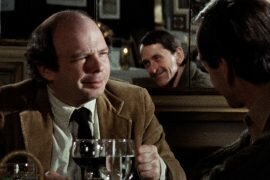“The world is so different in the daylight. In the dark, your fantasies get so out of hand. But in the daylight everything falls back into place again.” - These are the worlds spoken by the unconventional heroine played by Candance Hilligoss in a surreal and lonely horror film from 1962 called Carnival of Souls.
Mary suffers a traumatic car accident, a car drag and falls from the bridge in the car with two of her other friends to be the only one surviving and walking away from it, seemingly unhurt. Soon she starts to feel out of touch with herself and the rest of society. She continues her way to Utah where she got a job as a local church organist. We move fast from the scene of the accident to her seemingly “normal” continuation of life or so we think. In the car, on the way to the town , she sees a strange white faced The Man, a ghoul, that creeps her out but it doesn’t scare her. She meets another one in the boarding house where she checks in, this one in flesh and blood, the creepy John Liden, played by Sidney Berger. Linden makes inappropriate passes on her. At this point, Mary is drifting between reality and fantasy and she is at most drawn to the abandoned amusement park close to the city where she eventually decides to go although she was warned by the local priest and local psychiatric that it’s not the most smartest idea. She is again drawned by the white faced Man to participate in a strange dance of death with other ghouls and zombie lookalike creatures who try to suffocate her only to have the film cut back to the car accident where we now see three people dead, including Mary.
The strange abandoned place is the famous ballhouse Saltair in Utah, that had more the one destiny, three times burned or renovated and the version from 1925 was the one where the film was shot. Herk Harvey, a film director saw the park on his way back to California trough Salt Lake City and was so intrigued by the light and the lake behind it, that seemed like the weirdest place he’d ever seen. Harvey asked John Clifford, a writer to write a script that in the end centered around a fragile and out of touch girl Mary. The use of the church organs was very effective and smart decision as it did not require a lot of visual effects but created an eerie and minimalist feel of the film.
Carnival of Souls is considered a classic and a cult film today, but it didn’t have that reputation for a long time. At the premiere the audience did not “get it” due to its loose narrative and a rather heavy atmosphere. It is not your typical horror film, but it’s definitely ahead of its time as it emerges as a first low budget horror film to make space for the ones coming after like Night of The Living Dead by George A. Romero. The main plot is the idea of afterlife which was not explored for the first time on film or television, first coming to mind is the episode of the series The Twilight Zone called “The Hitchhiker” from the 1960. But Carnival of Souls has this loneliness and eeriness to it, that not many horror films are able to create. It is a check-in to the final destination, the afterlife, the permanent death, the ballroom, where this “ordinary world”, the world of living seems (or is) more creepy and hysterical, filled with people not wanting you or wishing you a whole lot of good. It’s probably the saddest and loneliest horror film.
Mary is an outsider, outcast in this and that world. She is also one of the first female horror characters put on a sort of subjectivity court for not wanting to dance, or drink or have fun. She is being accused of her personality and introverted character. She is persued and followed and told what she needs to do and how she needs to think. It’s an eerie and lonely portrait of a persons soul that is lost somewhere between life and death and does not know which one is right choice. If there is such a choice to be made in the first place.



